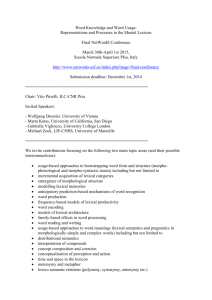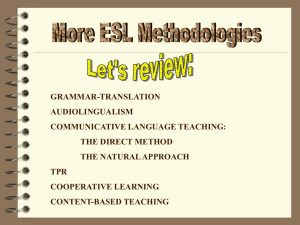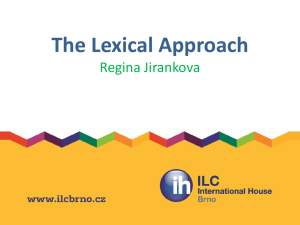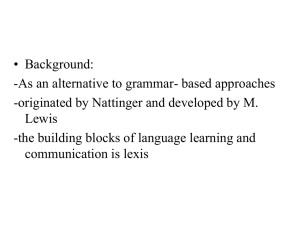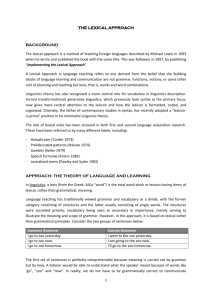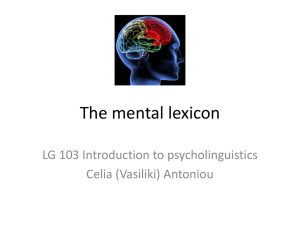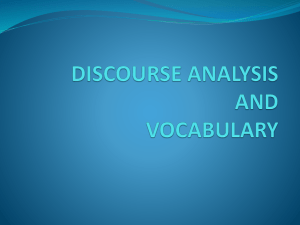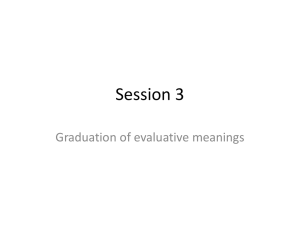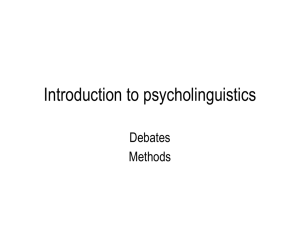LG 637
advertisement
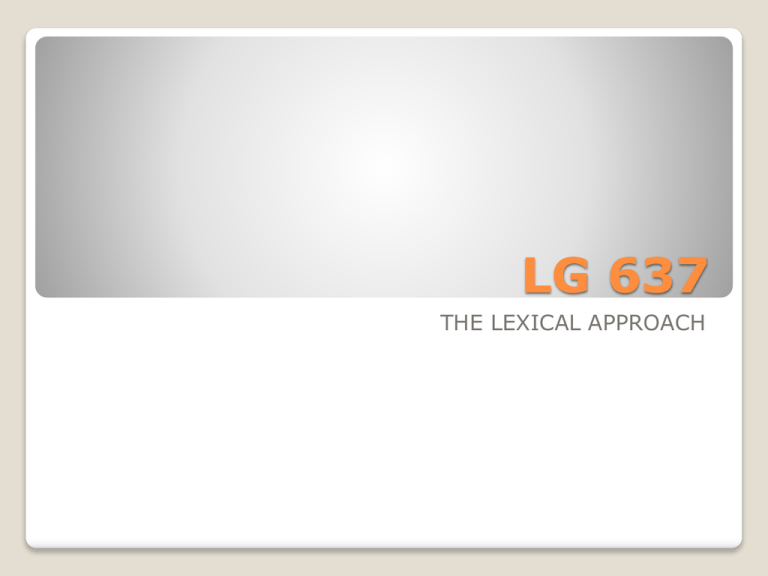
LG 637 THE LEXICAL APPROACH Standard view of language as structure and words; The Lexical Approach proposes that language consists of chunks which produce continuous coherent text in combination. 4 basic different kinds of chunks. One is single words while the others are multi-word. There are Words, Collocations Fixed Expressions Semi-Fixed Expressions What is Lexis? Found and explained in dictionaries. Words which stand alone, OPEN/CERTAINLY are lexical items, as are words were a single substitution produces a new meaning I like DOGS/CATS. The largest item in the lexicon. Much of the lexicon consists of multi-word items; items may occur in non-reversible combinations such as bread and butter, fish and chips…these are arbitrary combinations, or polywords. Words. Certain words co-occur in natural text with greater than random frequency. Most collocations as partnerships in which a certain slot may be filled by a partner word or limited number of partner words. Fixed idioms: Only one way to complete..To pull the ….over my eyes/ the tail wagging the……./ There are many more phrases, while not fully fixed, are likely to be completed in a small number of ways…. A bar of…./we had a ….time/ Collocations Language teaching recognises and uses certain types of fixed expressions. Some are fully fixed and others have slots that receive a choice of words, usually limited. Good morning//no thank you//Happy Birthday//can you tell me the way to…. Also as idioms…storm in a teacup Fixed expressions Almost fixed expressions: which permit minimal variation..//its/that’s not my fault. Spoken sentences with a simple slot: could you pass….please? Slot is filled by a specific kind of filler. I haven’t seen you since/for [+ time expression] Semi-Fixed expressions Chomsky’s view of language was generative, emphasising that speakers had a capacity to create and interpret unique sentences, an infinite range of possibilities, never produced or previously heard, the Lexical Approach holds that only a minority of spoken sentences are entirely new creations, that multiword units or chunks, memorised patterns form a high proportion of the fluent stretches of speech used in everyday conversation. A More General Approach Collocation is also important in lexical theories of language, referring to the regular occurrence together of words. i.e. DO….my hair/the cooking/the laundry/my work MAKE…my bed/a promise/coffee/a meal. Many other lexical units occur in language, such as: Binomials: clean and tidy, back and front.. Trinomials cool, calm, and collected.. IDIOMS dead drunk, to run up a bill., CONNECTIVES. Finally, to conclude CONVERSATIONAL GAMBITS Guess what? The Theory of Language in The Lexical Approach. Collins Cobuild English course represent an ambitious attempt to realise a syllabus and accompanying materials based on a lexical rather than grammatical principles. It was not a commercial success. Willis notes that the computer analyses of texts indicates that the most frequent 700 words of English account for around 70% of all English text. It was decided that word frequency would decide the course content. Level 1 would aim to cover the most frequent 700 words of the language DESIGN The use of activities that typically draw learners attention to lexical collocations and seek to enhance their retention and use of collocations. Teachers could re-examine their coursebooks for collocations, adding exercise that focus on lexical phrases. They should develop activities that allow learners to discover collocations for themselves both in the classroom and in the language they encounter outside of the classroom. Teaching students to teach themselves is aimed at. Collocation is mainly a matter of noticing and recording, so that trained students should be able to explore texts for themselves PROCEDURES The single most formidable task for the learner is mastering a sufficiently large lexicon. English, with its combination of German and romance source lexicons, may be a particular problem. Moderately competent users of English must have a good knowledge of the 2000 most common words. The next thousand are met comparatively infrequently, but are essential for intermediate level comprehension. Any specialised use requires another substantial vocabulary. For example several hundred words are essential for university students to function in an academic environment EXPANDING THE LEARNERS LEXICON Don’t worry if you don’t understand everything when listening or reading, a lot of listening/reading, partially understood, will help you much more than a small quantity where you understood every single word. Don’t worry about confusion and mistakes, they are a positive sign that you partly understand, not a negative one that you didn’t understand anything,. Sometimes grammar mistakes are made through not knowing enough vocabulary: if you want to avoid grammar mistakes, building your vocabulary will help you moiré than lots of grammar practise. Try to learn whole expressions containing useful words, rather than just the words alone, even though that seems much more difficult. When you record a new lexical pattern/item in your notebook, consciously try to think of other examples similar to those of the patter. It is not wasting time to explore certain words slowly and carefully. LEARNING STRATEGIES. Modern dictionaries provide good descriptions and are excellent at helping learners de-code meaning rather than translate. Simple dictionaries may assume synonymy of meaning rather than similarity, someone word is f defined by giving another with the ‘same ‘ meaning. So many dictionaries assume that one word may be defined through other words. A better way of looking at meaning between two words of similar meaning may be precisely by looking at their different collocational profiles. A more useful kind of dictionary would include lists of collocates to supplement the traditional definition. LEXIS IN DICTIONARIES. The lexical approach is not purely that language consists of prefabricated, prebuilt items, but that much more language than we have previously thought is stored and produced in this way. The lexical approach is far from language being the product of the Application of rules, most language is acquired lexically, then broken down, and then may be reassembled in potentially new combinations. This suggests we need to make changes to the kind of input, particularly in the early stages of learning, which will be most appropriate and useful in helping learners develop the ability to produce novel language on the basis of what is initially memorised as lexical intake. LEXIS AND GRAMMAR. Much language is acquired and remembered lexically. After several meetings a lexical item is incorporated into the learners’ lexicons. With a sufficiently large lexicon they break lexical items into pieces and gradually develop awareness of the possibilities of recombining parts into new combinations, prefabricated lexis is the basis for analysis and later novel re-synthesis. This is essentially a holistic view which integrates lexis and grammar. AN INTEGRATED APPROACH. Lewis, M. 2000. Teaching Collocation: Further Developments in the Lexical Approach. LTP. Hill, J. & Lewis, M. 1998. The LTP Dictionary of Selected Collocations. LTP. Nattinger, J. & DeCarrico. 1992. Lexical Phrases and Language Teaching. OUP. Bahns, J.1993. Lexical Collocations: A Contrastive View. ELT Journal. 7/1. Lewis, M. 1993. The Lexical Approach: A Way Forward. LTP Press. Lewis, M. 1997. Implementing The Lexical Approach. LTP Press. REFERENCES
